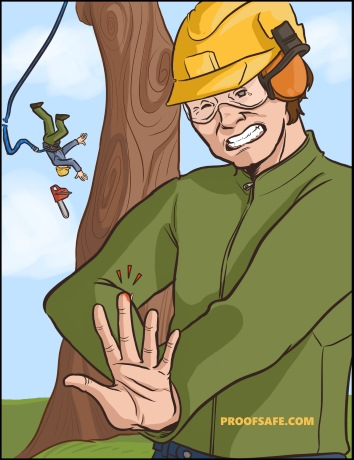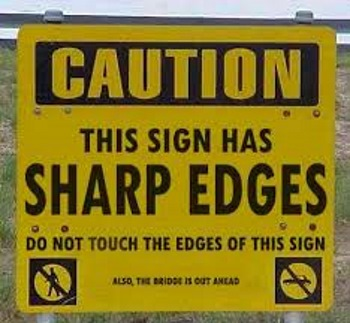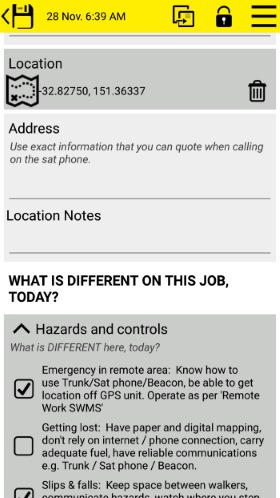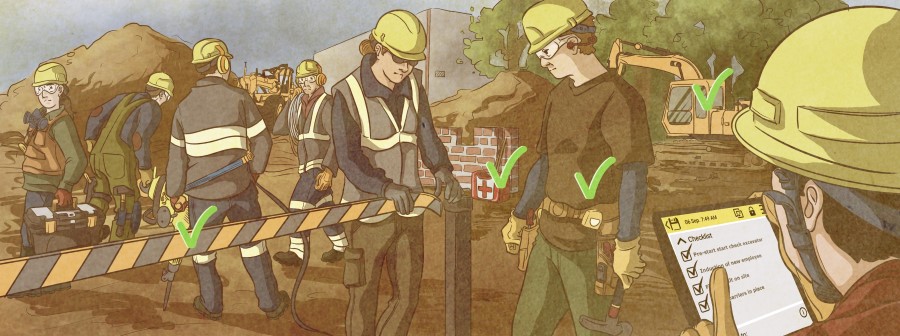Operating a business is complex and implementing safety systems can increase the complexity for managers - however, the law is clear; you must have and use a 'Safety System' which includes documents such as JSA forms and SWMS.
The OHS/WHS Compliance industry has come up with mountains of jargon, acronyms and technical bs which is often boring and very unlikely to be read. Here we keep it simple.

How to get OHS / WHS / HWS compliant
There are the three components to Safety Compliance:
- Keep everyone safe
- Have a system - you can't just wing it, and
- Maintain documents to prove you have a system
1. Keep everyone safe
Your organisation must ensure all workers, bystanders and anyone else who comes along later, isn't hurt. If someone is injured, then the injury of itself is almost (but not quite) proof that you failed. If there is a serious injury there’s a good chance you will face prosecution.
Even if the injured person is an utter idiot, at fault and you had done a reasonable job of protecting everyone, you might still go through a couple of years of significant turmoil, loss of contracts, loss of reputation, a probing investigation into your most private business orifices, financial stress, personal stress . . . before the case is finally dropped just before the hearing.
So make sure you keep everyone and the environment safe. The best way ONLY WAY to do this consistently is with 'Culture' - Meaning your entire team actually cares about keeping everyone safe. Workplaces are dynamic so the entire team has to be thinking safety all the time, speaking up and keeping each other accountable all the time. Just having a written 'System' parked on the shelf such as an Occupational Health and Safety Management System (OHSMS) is unlikely to protect everyone unless the culture is right.
2. Have a Safety System (OHSMS / SafetyMAP etc)

The law is clear: you must have a 'system' however the law doesn't mandate the design of your system. Your workplace is unique, so what the lawmakers are saying is "you're the experts at what you do, so you design a system that fits".
The system can be relatively simple, actually, we would say the simpler, the better.
Your system needs a few things including:
- Safety policy - A statement that says "We care and we'll make sure we protect people and the environment". Effectively making a promise.
- Big picture stuff - How your safety system will be managed, for example: "Each team will meet each week, we'll do internal audits every month, we'll get an external expert every year, SWMS's will be reviewed each 6 months, we'll use ProofSafe digital forms for recording data and events" etc.
- The detail - The smaller, more detailed processes: "field teams will assess every site, every day and all teams will have an emergency plan. Inductions will be thorough for new employees and a 2 minute briefing for visitors. PPE will include protective boots and sun hats. Training will be outsourced and dolphins will be patted gently, if at all.
- Record keeping - A system of recording safety related data and events, could be digital such as ProofSafe or paper (see point 3 below). You need records that are thorough and can be searched.
(ProofSafe is tailored to simplify all your audits, equipment records, safety meeting records, internal feedback, PPE records, training records, Pre-start checks, etc)
Putting an OHS/WHS system together can take a lot of time however it's essential for legal workplace compliance. Additionally Work Providers putting out tenders will want to see your entire documented system, you can't get large contracts without comprehensive OHS / WHS documents.
3. Documents (digital or paper)
Workplace safety documents can become a massive, time consuming, frustrating disaster. Legally you MUST have them, but keep in mind all your systems should be 'practicable', this means 'doable' so if you force the team to fill in four pages of tick boxes before every job, then this is a massive waste of time, frustrating for workers and a disincentive for teams 'to care'. Your documents should be designed in consultation with workers and be simple.
Documents suited for many higher risk industries may include:
- SWMS's - Safe Work Method Statements put together for all higher risk tasks
- JSEA's (JSA's) - Job Safety & Environmental Analysis - A pre-start check of the day's work
- Induction form
- Audit form
- Incident report
- Staff & training records
- Maintenance or Asset Log - for recording inspections, problems and repairs to equipment
- Safety notes - All the small stuff such as one-off conversations, tailgate meetings, feedback, suggestions, etc.
The names above are examples only. You will often find the same names used to mean different things, it can get confusing. Legally you can use nearly any name you like, perhaps: 'ACE' - Arse Covering Exercise!
The exception to flexible naming is where there are regulatory requirements, for example regulations require a Safe Work Method Statement (SWMS) for high risk and construction work, additionally 'licence' has a specific legal meaning.
In summary: all organisations and individuals are legally obligated 'To Care' and to maintain a documented system that proves they care. If authorities get involved after an accident then the charges laid may include both a failure to properly care AND a failure to maintain adequate documentation.

SWMS vs JSA / JSEA - What's the difference
These two terms (JSA and SWMS) get confused and interchanged a bit. As discussed above you can call most of your documents whatever you want but most often it works like this:
-
SWMS - Safe Work Method Statement
A document (see image above) put together for a certain activity, an example might be: 'Chainsaw Use', the team would sit down and discuss all the tasks and then the ways people might get hurt when someone is using a chainsaw. Then for each 'Hazard', the team decides the level of risk, the mitigation (fixing and preventing) methods and who is responsible for implementing the fixes.- ACTIVITY - Chainsaw use
- TASK - Cutting timber
- HAZARD - Cut to operator's legs
- RISK - High
- CONTROL - Wear chainsaw pants and provide training
- RESPONSIBLE PEOPLE - Supervisor to supply pants and training, Staff to use pants
- REVIEW - periodically review if controls are working and are the best practicable option.
-
JSA - Job Safety Analysis
A form filled in at the start of a new job, new day or new site to prove the team has assessed the hazards and risk specific to that day on that site. This includes the safety of people and the safety of the environment.
It is this form that often becomes a ridiculous, reactive, bum covering ream of paper that helps nobody and damages the safety culture because it is too long.
Most hazards and risks are documented within the SWMS's - those common hazards have been considered, documented, trained to and reviewed. Leave them alone. The JSA should just be for what is new or unusual on this job on this day - for example, a storm on the horizon, the school down the street or the new team member on the chainsaw.
An effective JSA will:- be short
- encourage an honest conversation
- include a review of the emergency plan for the site, and
- provide evidence of the process.
-
JSEA - Job Safety & Environmental Analysis
Exactly the same as above but harder to say.

ProofSafe Digital Safety System
ProofSafe can consult on your safety documentation such as SWMS's and policies.
And
ProofSafe replaces paper systems making it much easier for organisations to keep systems, documents, forms and reports up to date. Additionally ProofSafe can replace almost any other paper system such as time-sheets, quoting or data collection for research and reports.
Try the App free now:
iPad / iPhone
- ![]() Android -
Android - ![]()
Username - guest1
Password - demo1
